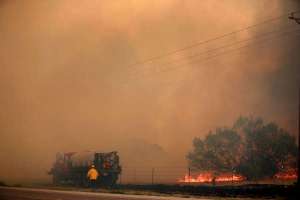
Volunteer firefighters work on a wildfire in Graford, Texas. Credit: Tom Pennington / Getty Images News
First Texas was parched—now it’s burning. Still in the grips of its worst drought since the 1950s, Texas is grappling with violent wildfires that have already destroyed more than 1,000 homes and killed two people. While more than 3.6 million acres of Texas have been scorched since the drought tightened last November, over the weekend authorities responded to 63 new fires, the worst of which burned just east of the capital of Austin. Texas Governor Rick Perry was forced to leave the Presidential campaign trail on Monday, returning home from South Carolina to help oversee the rescue efforts.
Speaking from Steiner Ranch outside Austin, Perry surveyed the damage:
These fires are serious and widespread, and as mean as I have ever seen, burning more than 1,000 homes since this wildfire season began. Texas appreciates the resources and support we continue to receive from across the state and across the country to fight these fires, and the efforts of the brave men and women who put themselves in harm’s way to protect Texans’ lives and property. Our thoughts and prayers are with those who are impacted by these fires.
More from TIME: Parched Earth
Obviously the lingering drought and brutally high temperatures throughout much of the state—poor Austin has had over 70 consecutive days above 100 F this summer—has primed Texas for an inferno. Ironically, though, the fires have been stoked by nearby Tropical Storm Lee, which dumped rain on the Gulf Coast even as its winds spread fires in neighboring Texas. That’s left those in the path of the wildfires virtually homeless, lucky to escape with their lives:
In Bastrop, a town of about 6,000 people along the Colorado River, huge clouds of smoke soared into the sky and hung over downtown Monday.
When winds picked up, flames flared over the tops of trees. Helicopters and planes loaded with water flew overhead, and firefighters along a state highway outside the city converged around homes catching fire.
“Waiting is the most frustrating thing,” said Gina Thurman, 47, choking back tears as she sat by herself in the shade on a curb outside Ascension Catholic Church, one of several shelters in the area. “You’re sitting there and you don’t know anything but your house is probably burning.”
Rick Blakely was among about 30 people sleeping on cots at the church. The 54-year-old said he was in a state of shock and “not expecting anything to be standing” when he returned to his home.
“I just don’t know what I’m going to do,” he said.
More from TIME: The Great California Fires
What’s amazing is that even as Texas endures wildfires and a drought that shows no sign of letting up, much of the rest of the country has been deluged with water. Upstate New York and Vermont are just now beginning to recover from the flooding caused by Hurricane Irene, and earlier in the year upper Midwest farmland experienced crop-destroying floods. With a little less than four months to go, 2011 is already shaping up to be one of the most expensive years for natural disasters in U.S. history. The fires of Texas and the floods of the Northeast are a reminder that the weather threats America will face in the years to come will be as diverse as they are dangerous—which just makes the need for preparation all the more important.
More from Ecocentric: Welcome to the Era of the Everyday Billion-Dollar Disaster
Bryan Walsh is a senior writer at TIME. Find him on Twitter at @bryanrwalsh. You can also continue the discussion on TIME’s Facebook page and on Twitter at @TIME


